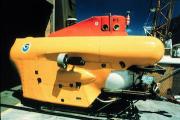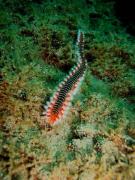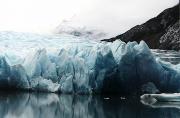Radio Program
Our regular Science and the SeaTM radio program presents marine science topics in an engaging two-minute story format. Our script writers gather ideas for the radio program from the University of Texas Marine Science Institute's researchers and from our very popular college class, Introduction to Oceanography, which we teach to hundreds of non-science majors at The University of Texas at Austin every year. Our radio programs are distributed at to commercial and public radio stations across the country.
A sperm whale can dive thousands of feet deep to catch its fill of squid. The pressure causes its rib cage to buckle inward and its lungs to collapse. Yet the whale survives just fine because that’s what’s supposed to happen. Not so with people, though. Depths of a hundred feet can cause problems, and anything below a few hundred feet is fatal.
The pressure is caused by the weight of the water above. Every 33 feet in depth adds the equivalent of the pressure of the atmosphere at sea level — 14 and a half pounds per square inch.
A foggy California coastline is a staple of Hollywood mysteries and horror tales, enfolding everything from murderers to monsters. Today, the California fog is enfolding another hazard: a nasty form of mercury. There’s not enough of it to hurt people, but it may have effects on other life.
Researchers began studying the fog in 2011. They knew that, during the summer months, the level of mercury went up in Monterey Bay, near San Francisco. They wondered whether some of the mercury could make its way into the fog and drift ashore.
Marine creatures don’t have to be big to deliver a nasty jolt. Consider the bearded fireworm. It’s generally no more than a few inches long, but one touch can be a big problem. Tiny bristles on its flanks can inject a powerful neurotoxin. The site of the wound feels like it’s on fire — a sensation that can last for hours.
In the eastern North Atlantic Ocean, hundreds of miles off the coast of Europe, the continents are slipping away from each other. Three of the “plates” that make up Earth’s crust are sliding apart, allowing molten rock to push up from below, building new crust. That process is also building a chain of islands that’s one of the most “active” spots on the planet.
The Azores consists of nine major islands. They stretch across about 350 miles, and are home to a quarter of a million inhabitants.
It’s been 65 million years since the last ammonites died off. Yet these creatures are whispering to geologists, helping them determine the ages of layers of rock that could be up to 200 million years old.
Ammonites were relatives of modern-day squid and octopuses. But unlike those creatures, the ammonite lived inside a beautiful shell. The shell usually formed a coil, although some shells were straight or shaped like a helix.
During the 1930s, millions of Americans in the Great Plains saw their farms literally blow away. A deadly drought, combined with poor farming techniques, created the Dust Bowl. Millions of tons of topsoil blew away in black, choking clouds. And that led to a massive migration, as millions of Americans moved west in hopes of a better life.
A new climate-related migration might take place later in this century. Millions of Americans might be forced to flee the coastline because of rising sea levels — the result of our planet’s warming climate.
Imagine skimming across the waves in a long, skinny boat with a few hundred siblings. Some of them paddle, some steer, some throw fishing lines in the water, and the lucky ones get to eat. That’s the life of a siphonophore, an organism that consists of a bunch of smaller organisms all working together as a single colony — and all of them descended from the same egg.
In just about every movie involving a submarine, there’s a dramatic attack scene. The sonar operator monitors the sound of the propellers of ships passing overhead, or sends out a “ping” and listens for its echo off the hull of another sub. He then gives the captain precise details on the location and speed of the enemy vessels.
A trip to the grocery store usually requires a basket to hold all the goodies. But a relative of the well-known sea star doesn’t need to grab a basket to hold its groceries — it already has one.
The basket star is found in cold to warm waters in both the northern and southern hemispheres, generally at depths of no more than a few hundred feet. It’s found on the west coast of the United States down to California, and on the east coast down to Massachusetts. It prefers a rocky sea floor, in a spot with a pretty strong current.
It’s hard to think of anything quieter than melting ice. But when the melting ice weighs thousands of tons and is thousands of years old, it can sound like a truckload of Rice Krispies dumped into a swimming pool.
In fact, scientists have found that melting glaciers can be louder than anything else in the oceans — louder even than hurricanes. Glaciers were already known to create some impressive underwater sounds. When a chunk breaks off to form an iceberg, the sound can be heard hundreds of miles away.











